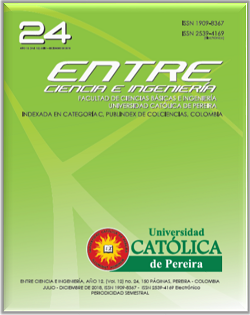Urban runoff control through Sustainable Urban Drainage Systems (SUDS): Wells / Infi ltration trenches
DOI:
https://doi.org/10.31908/19098367.3813Keywords:
SUDS, Hydrology, Hydraulics, infiltration trench, EPA SWMMM, LID Controls, Saint-Venant, BMPsAbstract
In the framework of the efficient managementof water resources and the environment, the control of thesurface run off is an area of study of great importance in the development of cities, because their exponential growth and the increase of non-permeable hard zones produces greater runoff transport times. Thus, environmental and economic implications are generated that leads to the implementation of mayor structures for the respective transport. When the control by these elements is not possible, flood phenomena aff ect thequality of life of the population and emergency plans for these risks must be generated. The implementation of alternative sustainable drainage systems such as Sustainable UrbanDrainage Systems (SUDS) allows to reduce and to delay thestorm surges that occur in. Next, an analysis of results relatedto hydraulic and hydrological modeling and the EPA-SWMM,a program developed by the United States EnvironmentalProtection Agency (EPA) for the analysis of rainfall andhydraulic behavior of networks of Sewerage
References
Banco Mundial Colombia, Gestion del Riesgo. «http://gestiondelriesgo. gov.co,» 2012. [En línea]. Available: http://gestiondelriesgo.gov.co/ sigpad/archivos/GESTIONDELRIESGOWEB.pdf. Recuperado el 22 de abril de 2018.
Us Environmental Protection Agency, Storm Water Management Model Reference Manual, vol. I - Hidrology, Us Environmental Protection Agency, 2016.
US Environmental Protection Agency, Storm Water Management Model Reference Manual, vol. III - Water Quality, US Environmental Protection Agency, 2016.
Rodriguez, J., Rodríguez, J., Gómez, E. y Castro, D., “Sistemas urbanos de drenaje sostenible, SUDS”, 2009. [En línea]. Available: http://www.caminospaisvasco.com/Profesion/Publicaciones%20 de%20nuestros%20colegiados/suds.
Secretaría Distrital de Ambiente - Subdirección de Ecourbanismo yGestión Ambiental, «http://ambientebogota.gov.co/,» 2011. [En línea].Available: http://ambientebogota.gov.co/documents/10157/73754/Sistema+Urbanos+de+Drenaje+Sostenible.
Sánchez, J. R., “Nuevas tendencias en la gestión de drenaje pluvial enuna cuenca urbana”, España: Universidad de la Rioja, 2012.
Construction Industry Research and Information Association, CIRIAC523 (2001). Sustainable urban drainage systems, best practice manual for England, Scotland, Wales and Northern Ireland, Londres, RU:Construction Industry Research and Information Association, 2001, p.131.
Ministerio de Vivienda y Urbanismo. Dirección de InvestigacionesCientíficas y Tecnológicas. Técnicas alternativas para soluciones deaguas lluvias en sectores urbanos. Guía de diseño, Santiago, Chile,1996, p. 670.
Chow, V. T., Maidment, D. R. y Mays, L. W., Hidrología AplicadaMcGraw-Hill Interamericana, S.A., 1994.
Cano, O. M., “Low impacy development (LID) opportunities in thedistrict of lamúd, Perú: a study of hydrology, cost and maintenance ofappropriate stormwater best management practices (BMPs)”, Michigan Technological University, Michigan, EEUU, 2015.
Ministerio de Vivienda, Ciudad y Territorio, «www.minvivienda.gov.co,» 01 Diciembre 2000. [En línea]. Available: http://www.minvivienda.gov.co/Documents/ViceministerioAgua/TITULO_D.pdf. [Últimoacceso: 2016].








 Revista Entre Ciencia e Ingeniería
Revista Entre Ciencia e Ingeniería .png) entrecei@ucp.edu.co
entrecei@ucp.edu.co.png) ISSN (Impreso) 1909-8367 - ISSN (En Línea) 2539-4169
ISSN (Impreso) 1909-8367 - ISSN (En Línea) 2539-4169 Attribution-NonCommercial 4.0 International (CC By-NC 4.0)
Attribution-NonCommercial 4.0 International (CC By-NC 4.0)
.png) Carrera 21 No. 49-95 Av. de las Américas, Pereira, Risaralda, Colombia
Carrera 21 No. 49-95 Av. de las Américas, Pereira, Risaralda, Colombia